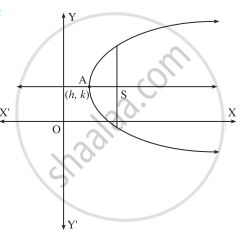Advertisements
Advertisements
प्रश्न
Find the differential equation all parabolas having a length of latus rectum 4a and axis is parallel to the axis.
उत्तर

Let A(h, k) be the vertex of the parabola whose length of the latus rectum is 4a.
Then the equation of the parabola is
(y - k)2 = 4a(x - h), where h and k are arbitrary constants. Differentiating w.r.t. x, we get
`2("y - k") * "d"/"dx" ("y - k") = 4"a" "d"/"dx" ("x - h")`
∴ `2("y - k")("dy"/"dx" - 0) = "4a"(1 - 0)`
∴ `2("y - k")"dy"/"dx" = "4a"`
∴ `("y - k")"dy"/"dx" = "2a"` ...(1)
Differentiating again w.r.t. x, we get
`("y - k") * "d"/"dx" ("dy"/"dx") + "dy"/"dx" * "d"/"dx" ("y - k") = 0`
∴ `("y - k")("d"^2"y")/"dx"^2 + "dy"/"dx" * ("dy"/"dx" - 0) = 0`
∴ `("y - k")("d"^2"y")/"dx"^2 + ("dy"/"dx")^2 = 0`
∴ `"2a"/(("dy"/"dx")) * ("d"^2"y")/"dx"^2 + ("dy"/"dx")^2 = 0` ....[By (1)]
∴ `"2a" ("d"^2"y")/"dx"^2 + ("dy"/"dx")^3 = 0`
This is the required D.E.
APPEARS IN
संबंधित प्रश्न
Obtain the differential equation by eliminating the arbitrary constants from the following equation:
Ax2 + By2 = 1
Obtain the differential equation by eliminating the arbitrary constants from the following equation:
y = Ae5x + Be-5x
Obtain the differential equation by eliminating the arbitrary constants from the following equation:
c1x3 + c2y2 = 5
Obtain the differential equation by eliminating the arbitrary constants from the following equation:
y = e−2x (A cos x + B sin x)
Find the differential equation of the ellipse whose major axis is twice its minor axis.
Form the differential equation of family of lines parallel to the line 2x + 3y + 4 = 0.
In the following example verify that the given expression is a solution of the corresponding differential equation:
xy = log y +c; `"dy"/"dx" = "y"^2/(1 - "xy")`
Solve the following differential equation:
`2"e"^("x + 2y") "dx" - 3"dy" = 0`
Reduce the following differential equation to the variable separable form and hence solve:
`"x + y""dy"/"dx" = sec("x"^2 + "y"^2)`
Choose the correct option from the given alternatives:
The solution of `"dy"/"dx" + "y" = cos "x" - sin "x"`
The particular solution of `dy/dx = xe^(y - x)`, when x = y = 0 is ______.
In the following example verify that the given function is a solution of the differential equation.
`"xy" = "ae"^"x" + "be"^-"x" + "x"^2; "x" ("d"^2"y")/"dx"^2 + 2 "dy"/"dx" + "x"^2 = "xy" + 2`
Obtain the differential equation by eliminating the arbitrary constants from the following equation:
(y - a)2 = b(x + 4)
Obtain the differential equation by eliminating the arbitrary constants from the following equation:
y = `sqrt("a" cos (log "x") + "b" sin (log "x"))`
Obtain the differential equation by eliminating the arbitrary constants from the following equation:
y = `"Ae"^(3"x" + 1) + "Be"^(- 3"x" + 1)`
Form the differential equation of all parabolas which have 4b as latus rectum and whose axis is parallel to the Y-axis.
Form the differential equation of the hyperbola whose length of transverse and conjugate axes are half of that of the given hyperbola `"x"^2/16 - "y"^2/36 = "k"`.
Solve the following differential equation:
`"dy"/"dx" = "x"^2"y" + "y"`
Solve the following differential equation:
y log y = (log y2 - x) `"dy"/"dx"`
Solve the following differential equation:
`"dx"/"dy" + "8x" = 5"e"^(- 3"y")`
Find the particular solution of the following differential equation:
`"dy"/"dx" - 3"y" cot "x" = sin "2x"`, when `"y"(pi/2) = 2`
Select and write the correct alternative from the given option for the question
General solution of `y - x ("d"y)/("d"x)` = 0 is
Find the differential equation of family of lines making equal intercepts on coordinate axes
Find the differential equation by eliminating arbitrary constants from the relation x2 + y2 = 2ax
Find the differential equation by eliminating arbitrary constants from the relation y = (c1 + c2x)ex
Find the differential equation from the relation x2 + 4y2 = 4b2
The family of curves y = `e^("a" sin x)`, where a is an arbitrary constant, is represented by the differential equation.
Find the differential equation of the family of all non-vertical lines in a plane
Find the differential equation of the family of all non-horizontal lines in a plane
The general solution of the differential equation of all circles having centre at A(- 1, 2) is ______.
The differential equation for all the straight lines which are at the distance of 2 units from the origin is ______.
Form the differential equation of all lines which makes intercept 3 on x-axis.
The differential equation representing the family of ellipse having foci either on the x-axis or on the y-axis centre at the origin and passing through the point (0, 3) is ______.
The differential equation of all parabolas whose axis is Y-axis, is ______.
If 2x = `y^(1/m) + y^(-1/m)`, then show that `(x^2 - 1) (dy/dx)^2` = m2y2
Form the differential equation whose general solution is y = a cos 2x + b sin 2x.
